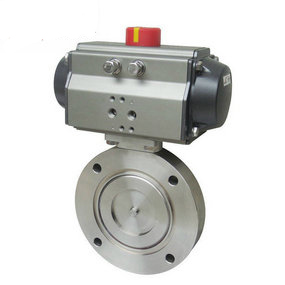How much power does the pneumatic low load regulating butterfly valve need? In terms of action mode, the gate valve is a straight travel valve, that is, the valve stem drives the valve plate to make vertical movement up and down to complete the opening and closing of the gate valve, so the flow resistance of the gate valve is small. However, because of its high opening height, the opening and closing speed is slow. The pneumatic butterfly valve is an angle travel valve, that is, the valve plate of the butterfly valve rotates 90 ° around the valve axis to complete the opening and closing of the butterfly valve. Therefore, the opening height of the butterfly valve is only one fourth of the channel diameter, so it can be opened and closed quickly. According to the function and purpose of the gate valve and butterfly valve, the gate valve has small flow resistance and good sealing performance. Because the gate valve plate and the medium flow direction are vertical angles, if the gate valve is not in place on the valve plate, the flushing of the medium on the valve plate will make the valve plate vibrate, which is very easy to damage the seal of the gate valve.

2、 Operating principle of pneumatic actuator:
1. When the compressed air enters the pneumatic actuator from nozzle A, the gas pushes the double pistons to move in a straight line towards both ends (cylinder head end). The rack on the piston drives the gear on the rotating shaft to rotate 90 degrees counterclockwise, and the valve is opened. At this time, the gas at both ends of the pneumatic actuator valve is discharged with nozzle B. On the contrary, when the compressed air enters both ends of the pneumatic actuator from the nozzle B, the gas pushes the double plug to move in a straight line in the middle. The rack on the piston drives the gear on the rotating shaft to rotate 90 degrees clockwise, and the valve is closed. At this time, the gas in the middle of the pneumatic actuator is discharged with nozzle A. The above is the transmission principle of the standard type. According to the user's needs, the pneumatic actuator can be installed in the opposite transmission principle to the standard type, that is, the valve is opened when the alignment shaft rotates clockwise, and closed when it rotates counterclockwise. Single acting (spring return type) pneumatic actuator nozzle A is the air inlet, nozzle B is the exhaust hole (nozzle B should be equipped with a muffler). The air inlet of nozzle A is to open the valve, and the valve is closed by spring force when the air is cut off.
2. The single action here means that the cylinder is reset with a spring. When gas failure or power failure occurs, the valve is reset by the spring in the cylinder to close or open the valve. (Normally closed or normally open optional). Double acting means that the cylinder is opened and closed by compressed air.




